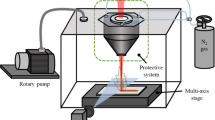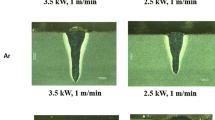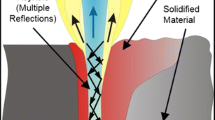Abstract
Vacuum laser beam welding, also known as subatmospheric laser welding, is a promising welding process that simultaneously offers deep penetration and sound welding quality. It has both the welding quality of electron beam welding and the flexibility of laser welding. In this study, vacuum laser beam welding was applied to Ti–6Al–4 V alloy, which has strong affinity with oxygen and which is usually welded via arc welding under a strictly controlled atmosphere or by electron beam welding in a vacuum chamber. In low vacuum laser welding, the ambient pressure was maintained at about 1 kPa by a vacuum pump while supplying shielding gas. The effects of the type of shielding gas, the shielding gas flow rate, and the nozzle stand-off distance on the laser-induced plume generation, degree of weld bead oxidation, and bead cross sections were investigated. Helium shielding was found to lead to excellent suppression of plume generation and bead oxidation regardless of the stand-off distance. For argon shielding, a low stand-off distance of 10 mm is necessary to prevent plume generation and oxidation. The shielding gas flow rate was not a critical parameter, unlike the type of shielding gas used and nozzle stand-off distance in this study.














Similar content being viewed by others
Availability of data and material
Not applicable.
Code availability
Not applicable.
References
Otani T (2007) Titanium welding technology. Nippon Steel Tech Rep 95:88–92
Eickhoff ST, Eagar TW (1990) Characterization of spatter in low-current GMAW of titanium alloy plate. Weld J 69(10):382–388
Shinn BW, Farson DF, Denney PE (2005) Laser stabilisation of arc cathode spots in titanium welding. Sci Technol Weld Joining 10(4):475–481
Mazumder J, Steen W (1982) Microstructure and mechanical properties of laser welded titanium 6Al-4V. Metall Trans A 13(5):865–871
Denney P, Metzbower E (1989) Laser beam welding of titanium. Weld J 68(8):342–346
Tsay L, Tsay C (1997) The effect of microstructures on the fatigue crack growth in Ti–6Al–4V laser welds. Int J Fatigue 19(10):713–720
Wang SH, Wei MD, Tsay LW (2003) Tensile properties of LBW welds in Ti–6Al–4V alloy at evaluated temperatures below 450 °C. Mater Lett 57(12):1815–1823
Cheng D, Huang J, Zhao X, Zhang H (2010) Microstructure and superplasticity of laser welded Ti–6Al–4V alloy. Mater Des 31(1):620–623
Bergmann J (2005) Mechanical behaviour of overlap joints of titanium. Sci Technol Weld Joining 10(1):50–60
Babu NK, Raman SGS, Murthy CVS, Reddy GM (2007) Effect of beam oscillation on fatigue life of Ti–6Al–4V electron beam weldments. Mater Sci Eng A 471(1–2):113–119
Vakili-Farahani F, Lungershausen J, Wasmer K (2016) Process parameter optimization for wobbling laser spot welding of Ti6Al4V alloy. Phys Proc 83:483–493
Chang B, Yuan Z, Pu H, Li H, Cheng H, Du D, Shan J (2017) A comparative study on the laser welding of Ti6Al4V alloy sheets in flat and horizontal positions. Appl Sci 7(4):376
Wang H, Shi Y, Gong S, Duan A (2007) Effect of assist gas flow on the gas shielding during laser deep penetration welding. J Mater Process Technol 184(1–3):379–385
Cao X, Jahazi M (2009) Effect of welding speed on butt joint quality of Ti–6Al–4V alloy welded using a high-power Nd:YAG laser. Opt Lasers Eng 47(11):1231–1241
Abe Y, Mizutani M, Kawahito Y, Katayama S (2010) Deep penetration welding with high power laser under vacuum. in Proceedings of International Congress on Applications of Lasers & Electro-Optics. https://doi.org/10.2351/1.5062094
Reisgen U, Olschok S, Longerich S (2010) Laser beam welding in vacuum–a process variation in comparison with electron beam welding. in Proceedings of International Congress on Applications of Lasers & Electro-Optics. https://doi.org/10.2351/1.5062093
Youhei A, Yousuke K, Hiroshi N, Koji N, Masami M, Seiji K (2014) Effect of reduced pressure atmosphere on weld geometry in partial penetration laser welding of stainless steel and aluminium alloy with high power and high brightness laser. Sci Technol Weld Joining 19(4):324–332
Börner C, Dilger K, Rominger V, Harrer T, Krüssel T, Löwer T (2011) Influence of ambient pressure on spattering and weld seam quality in laser beam welding with the solid-state laser. in Proceedings of International Congress on Applications of Lasers & Electro-Optics. https://doi.org/10.2351/1.5062302
Society AW (2007) Welding handbook, 9th edn. American Welding Society, Miami, FL
Elmer J, Vaja J, Carlton H (2016) The effect of reduced pressure on laser keyhole weld porosity and weld geometry in commercially pure titanium and nickel. Weld J 95:419–430
Reisgen U, Olschok S, Jakobs S, Turner C (2016) Laser beam welding under vacuum of high grade materials. Weld World 60(3):403–413
Gao M, Kawahito Y, Kajii S (2017) Observation and understanding in laser welding of pure titanium at subatmospheric pressure. Opt Express 25(12):13539–13548
Katayama S, Kobayashi Y, Mizutani M, Matsunawa A (2001) Effect of vacuum on penetration and defects in laser welding. J Laser Appl 13(5):187–192
Katayama S, Yohei A, Mizutani M, Kawahito Y (2011) Development of deep penetration welding technology with high brightness laser under vacuum. Phys Proc 12:75–80
Lee Y, Cheon J, Min B-K, Kim C (2019) Contamination of coupling glass and performance evaluation of protective system in vacuum laser beam welding. Appl Sci 9(23):5082
Shcheglov PY, Gumenyuk AV, Gornushkin IB, Rethmeier M, Petrovskiy VN (2013) Vapor–plasma plume investigation during high-power fiber laser welding. Laser Phys 23(1):016001
Ahn J, He E, Chen L, Dear J, Davies C (2017) The effect of Ar and He shielding gas on fibre laser weld shape and microstructure in AA 2024–T3. J Manuf Process 29:62–73
Börner C, Krüssel T, Dilger K (2013) Process characteristics of laser beam welding at reduced ambient pressure. in Proceedings of High-Power Laser Materials Processing: Lasers, Beam Delivery, Diagnostics, and Applications II.
Reisgen U, Olschok S, Jakobs S (2013) Laser beam welding in vacuum of thick plate structural steel. in Proceedings of International Congress on Applications of Lasers & Electro-Optics. https://doi.org/10.2351/1.5062897
Luo Y, Tang X, Lu F, Chen Q, Cui H (2015) Effect of subatmospheric pressure on plasma plume in fiber laser welding. J Mater Process Technol 215:219–224
Katayama S, Abe Y, Ido R, Mizutani M, Kawahito Y (2011) Deep penetration welding with high power disk lasers in low vacuum. in Proceedings of International Congress on Applications of Lasers & Electro-Optics. https://doi.org/10.2351/1.5062308
Kawahito Y, Matsumoto N, Mizutani M, Katayama S (2013) Characterisation of plasma induced during high power fibre laser welding of stainless steel. Sci Technol Weld Joining 13(8):744–748
Gao M, Chen C, Hu M, Guo L, Wang Z, Zeng X (2015) Characteristics of plasma plume in fiber laser welding of aluminum alloy. Appl Surf Sci 326:181–186
Jiang M, Tao W, Wang S, Li L, Chen Y (2017) Effect of ambient pressure on interaction between laser radiation and plasma plume in fiber laser welding. Vacuum 138:70–79
Society AW (2011) Structural Welding Code - Titanium, AWS D1.9/D1.9M:2007-ADD1
Li L, Peng G, Wang J, Gong J, Li H (2018) Experimental study on weld formation of Inconel 718 with fiber laser welding under reduced ambient pressure. Vacuum 151:140–147
Funding
Technical and financial support is provided by the KITECH (Korea Institute of Industrial Technology) of Republic of Korea (Grant EH-22–060).
Author information
Authors and Affiliations
Corresponding authors
Ethics declarations
Ethics approval
Not applicable.
Consent to participate
Not applicable.
Consent for publication
The authors agree to publish the manuscript.
Conflict of interest
The authors declare no competing interests.
Additional information
Publisher's Note
Springer Nature remains neutral with regard to jurisdictional claims in published maps and institutional affiliations.
Rights and permissions
Springer Nature or its licensor holds exclusive rights to this article under a publishing agreement with the author(s) or other rightsholder(s); author self-archiving of the accepted manuscript version of this article is solely governed by the terms of such publishing agreement and applicable law.
About this article
Cite this article
Lee, Y., Cheon, J., Min, BK. et al. Optimization of gas shielding for the vacuum laser beam welding of Ti–6Al–4 V titanium alloy. Int J Adv Manuf Technol 123, 1297–1305 (2022). https://doi.org/10.1007/s00170-022-10257-5
Received:
Accepted:
Published:
Issue Date:
DOI: https://doi.org/10.1007/s00170-022-10257-5




